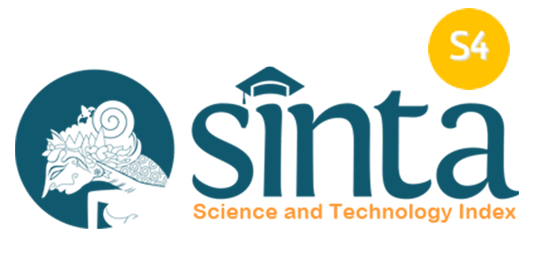EXPLORING THE COMPLEXITIES OF BILINGUAL APHASIA: IMPLICATIONS IN THE CONTEXT OF NEUROLINGUISTICS
DOI:
https://doi.org/10.26740/paramasastra.v12n1.p1-26Keywords:
bilingual aphasia , neurolinguistics, linguistics, language pathologyAbstract
Aphasia, a complex communication disorder resulting from brain damage, causes difficulties in understanding and using language. The phenomenon of bilingual aphasia is challenging due to its complexity in understanding and rehabilitating language disorders. In the globalization era, the dual-speaking population's growth is increasing. However, our understanding of bilingual aphasia is still limited. Therefore, in-depth and systematic research is needed to guide bilingual aphasia's diagnosis, treatment, and rehabilitation. This study used a rigorous literature review method, with a thematic search and analysis of relevant studies on bilingual aphasia. Symptom profiles, risk factors, pathophysiology, and rehabilitation strategies were comprehensively reviewed. The thematic analysis of the literature revealed diverse symptom profiles in individuals with bilingual aphasia and associated risk factors and pathophysiological mechanisms. In addition, this study examined effective rehabilitation strategies appropriate to the characteristics of bilingual aphasia. This research has important implications in neurolinguistics and aphasiology, improving the accuracy of diagnosis, development of appropriate interventions, and effective rehabilitation planning. The results make valuable contributions to clinical practitioners, researchers, and educators in providing better care and support for individuals with bilingual aphasia. In addition, this study also enriches our understanding of the complexity of language and the brain-language connection at large.
References
Aboh, E. O. (2020). Lessons From Neuro-(a)-Typical Brains: Universal Multilingualism, Code-Mixing, Recombination, and Executive Functions. Frontiers in Psychology, 11(1–16), 498805. https://doi.org/10.3389/fpsyg.2020.00488
Albert, M., & Obler, L. K. (1978). The Bilingual Brain: Neuropsychological and Neurolinguistic Aspects of Bilingualism. Academic Press.
Alduais, A., Alduais, A., Alfadda, H., & Allegretta, S. (2022). Clinical Linguistics: Analysis of Mapping Knowledge Domains in Past, Present and Future. Children, 9(8), 1–37. https://doi.org/10.3390/children9081202
Bahadoran-Baghbaderani, A., Tahririan, M. H., Saadatnia, M., & Ketabi, S. (2021). Contributions of Pre and Postmorbid Nondominant Language Interventions to Coactivation of L1-L2 Lexical Representations: A Case Study of Persian-English Bilingual Stroke-Induced Aphasic Patients. Journal of Research in Applied Linguistics, 12(1), 48–67. https://doi.org/10.22055/RALS.2021.16724Boye, K., & Bastiaanse, R. (2019). Grammatical versus lexical words in theory and aphasia: Integrating linguistics and neurolinguistics. Glossa, 4(1). https://doi.org/10.5334/gjgl.436
Brady, M. C., Ali, M., VandenBerg, K., Williams, L. J., Williams, L. R., Abo, M., Becker, F., Bowen, A., Brandenburg, C., Breitenstein, C., Bruehl, S., Copland, D. A., Cranfill, T. B., Pietro-Bachmann, M. di, Enderby, P., Fillingham, J., Lucia Galli, F., Gandolfi, M., Glize, B., … Harris Wright, H. (2022). Precision rehabilitation for aphasia by patient age, sex, aphasia severity, and time since stroke? A prespecified, systematic review-based, individual participant data, network, subgroup meta-analysis. International Journal of Stroke, 17(10), 1067–1077. https://doi.org/10.1177/17474930221097477
Brady, M. C., Kelly, H., Godwin, J., Enderby, P., & Campbell, P. (2016). Speech and language therapy for aphasia following stroke. In Cochrane Database of Systematic Reviews (Vol. 2016, Issue 6). John Wiley & Sons, Ltd. https://doi.org/10.1002/14651858.CD000425.pub4
Cargnelutti, E., Tomasino, B., & Fabbro, F. (2019). Aphasia in the Multilingual Population. In The Handbook of the Neuroscience of Multilingualism (pp. 533–552). John Wiley & Sons, Ltd. https://doi.org/10.1002/9781119387725.ch26
Chen, J. H. (2018). Losing A Language: A Qualitative Study of Code-Switching Among Taiwanese-Chinese Bilingual Aphasic Speakers with Selective Recovery Pattern. Journal of Advances in Linguistics, 9, 1452–1470. https://doi.org/10.24297/jal.v9i0.7917
Conner, P. S., Goral, M., Anema, I., Borodkin, K., Haendler, Y., Knoph, M., Mustelier, C., Paluska, E., Melnikova, Y., & Moeyaert, M. (2018). The role of language proficiency and linguistic distance in cross-linguistic treatment effects in aphasia. Clinical Linguistics and Phonetics, 32(8), 739–757. https://doi.org/10.1080/02699206.2018.1435723
Fallahi, M. H. (2017). A Report of “Bilingual Aphasia Test” on a Trilingual Broca’s Aphasic Patient’s Speech (A Case Study) Mohammad. Journal of Linguistics & Khorasan Dialects Biannual, 8(2), 15–17.
Fyndanis, V., Lind, M., Varlokosta, S., Kambanaros, M., Soroli, E., Ceder, K., Grohmann, K. K., Rofes, A., Simonsen, H. G., Bjekić, J., Gavarró, A., Kuvač Kraljević, J., Martínez-Ferreiro, S., Munarriz, A., Pourquie, M., Vuksanović, J., Zakariás, L., & Howard, D. (2017). Cross-linguistic adaptations of The Comprehensive Aphasia Test: Challenges and solutions. Clinical Linguistics and Phonetics, 31(7–9), 697–710. https://doi.org/10.1080/02699206.2017.1310299 Gilmore, N., Meier, E. L., Johnson, J. P., & Kiran, S. (2019). Nonlinguistic Cognitive Factors Predict Treatment-Induced Recovery in Chronic Poststroke Aphasia. Archives of Physical Medicine and Rehabilitation, 100(7), 1251–1258. https://doi.org/10.1016/j.apmr.2018.12.024Goral, M. (2001). Aphasia in Hebrew speakers. Journal of Neurolinguistics, 14(2), 297–312. https://doi.org/https://doi.org/10.1016/S0911-6044(01)00019-7
Grodzinsky, Y. (1984). The syntactic characterization of agrammatism. Cognition, 16(2), 99–120. https://doi.org/https://doi.org/10.1016/0010-0277(84)90001-5
Herath, H. M. D. P. M., Weraniyagoda, W. A. S. A., Rajapaksha, R. T. M., Wijesekara, P. A. D. S. N., Sudheera, K. L. K., & Chong, P. H. J. (2022). Automatic Assessment of Aphasic Speech Sensed by Audio Sensors for Classification into Aphasia Severity Levels to Recommend Speech Therapies. Sensors, 22(18), 6966. https://doi.org/10.3390/s22186966
Kambanaros, M., Michaelides, M., & Grohmann, K. K. (2017). Cross-linguistic transfer effects after phonologically based cognate therapy in a case of multilingual specific language impairment (SLI). International Journal of Language and Communication Disorders, 52(3), 270–284. https://doi.org/10.1111/1460-6984.12270
Khamis Dakwar, R., Ahmar, M., Farah, R., & Froud, K. (2018). Diglossic aphasia and the adaptation of the Bilingual Aphasia Test to Palestinian Arabic and Modern Standard Arabic. Journal of Neurolinguistics, 47, 131–144. https://doi.org/10.1016/j.jneuroling.2018.04.013 KK Nair, V., Rayner, T., Siyambalapitiya, S., & Biedermann, B. (2021). Domain-general cognitive control and domain-specific language control in bilingual aphasia: A systematic quantitative literature review. In Journal of Neurolinguistics (Vol. 60, p. 101021). Pergamon. https://doi.org/10.1016/j.jneuroling.2021.101021
Lahiri, D., Ardila, A., Dubey, S., Mukherjee, A., Chatterjee, K., & Ray, B. K. (2021). Effect of bilingualism on aphasia recovery. Aphasiology, 35(8), 1103–1124. https://doi.org/10.1080/02687038.2020.1812032
Lerman, A., Goral, M., Edmonds, L. A., & Obler, L. K. (2020). Measuring treatment outcome in severe Wernicke’s aphasia. Aphasiology, 34(12), 1487–1505. https://doi.org/10.1080/02687038.2020.1787729Lerman, A., Goral, M., Edmonds, L. A., & Obler, L. K. (2022). Strengthening the semantic verb network in multilingual people with aphasia: Within- A nd cross-language treatment effects. Bilingualism, 25(4), 645–659. https://doi.org/10.1017/S1366728921001036Lerman, A., Goral, M., & Obler, L. K. (2023). Rehabilitating an attrited language in a bilingual person with aphasia. Clinical Linguistics and Phonetics, 37(3), 272–290. https://doi.org/10.1080/02699206.2022.2052966
Lerman, A., Pazuelo, L., Kizner, L., Borodkin, K., & Goral, M. (2019). Language mixing patterns in a bilingual individual with non-fluent aphasia. Aphasiology, 33(9), 1137–1153. https://doi.org/10.1080/02687038.2018.1546821
Linden, L. Van der. (2018). A case study about the interplay between language control and cognitive abilities in bilingual differential aphasia: Behavioral and brain correlates. Journal of Neurolinguistics, 46, 37–68. https://doi.org/10.1016/j.jneuroling.2017.12.011
Muò, R., Raimondo, S., Martufi, F., Cavagna, N., Bassi, M., & Schindler, A. (2021). Cross-cultural adaptation and validation of the Italian Aachener Aphasie Bedside Test (I-AABT), a tool for Aphasia assessment in the acute phase. Aphasiology, 35(9), 1238–1261. https://doi.org/10.1080/02687038.2020.1819953
Nadeau, S. E. (2019). Bilingual aphasia: Explanations in population encoding. Journal of Neurolinguistics, 49, 117–143. https://doi.org/10.1016/j.jneuroling.2018.10.002Nasrullah, R., Suganda, D., Wagiati, & Riyanto, S. (2019). Recovery Patterns and A Linguistic Therapy Model of Sundanese-Indonesian Bilingual Aphasia: A Neurolinguistic Study. Indonesian Journal of Applied Linguistics, 9(2), 452–462. https://doi.org/10.17509/ijal.v9i2.20243
Nasrullah, R., Suganda, D., Wagiati, & Riyanto, S. (2021). Verbal-Lexical Expression ofIndonesian-Speaking Persons with Broca’s Aphasia. Ilkogretim Online-Elementary Education Online, 20(5), 692–706. https://doi.org/10.17051/ilkonline.2021.05.74
Nedergaard, J. S. K., Martínez-Ferreiro, S., Fortescue, M. D., & Boye, K. (2020). Non-fluent aphasia in a polysynthetic language: five case studies. Aphasiology, 34(6), 654–673. https://doi.org/10.1080/02687038.2019.1643000 Nickels, L., Hameau, S., Nair, V. K. K., Barr, P., & Biedermann, B. (2019). Ageing with bilingualism: benefits and challenges. Speech, Language and Hearing, 22(1), 32–50. https://doi.org/10.1080/2050571X.2018.1555988
Nikitha, M., Darshan, H. S., Abhishek, B. P., & Goswami, S. P. (2020). Clinical Profiling of a Bilingual Client with Anomic Aphasia. Annals of Neurosciences, 27(2), 75–82. https://doi.org/10.1177/0972753120927518
Paplikar, A., Mekala, S., Bak, T. H., Dharamkar, S., Alladi, S., & Kaul, S. (2019). Bilingualism and the severity of poststroke aphasia. Aphasiology, 33(1), 58–72. https://doi.org/10.1080/02687038.2017.1423272
Paradis, M. (2011). Principles Underlying the Bilingual Aphasia Test (BAT) and Its Uses. Clinical Linguistics & Phonetics, 25(6–7), 427–443. https://doi.org/10.3109/02699206.2011.560326
Parr, T., Rees, G., & Friston, K. J. (2018). Computational neuropsychology and bayesian inference. Frontiers in Human Neuroscience, 12(1–14), 332197. https://doi.org/10.3389/fnhum.2018.00061 Patra, A., Bose, A., & Marinis, T. (2020). Lexical and Cognitive Underpinnings of Verbal Fluency: Evidence from Bengali-English Bilingual Aphasia. Behavioral Sciences, 10(10). https://doi.org/10.3390/BS10100155
Pearce, J. M. S. (2005). A Note on Aphasia in Bilingual Patients : Pitres ’ and Ribot ’ s Laws. European Neurology, 54, 127–131. https://doi.org/10.1159/000089083
Peñaloza, C., Barrett, K., & Kiran, S. (2020). The influence of prestroke proficiency on poststroke lexical-semantic performance in bilingual aphasia. Aphasiology, 34(10), 1223–1240. https://doi.org/10.1080/02687038.2019.1666082
Peñaloza, C., & Kiran, S. (2019). Recovery and Rehabilitation Patterns in Bilingual and Multilingual Aphasia. In The Handbook of the Neuroscience of Multilingualism (pp. 553–571). John Wiley & Sons, Ltd. https://doi.org/10.1002/9781119387725.ch27
Downloads
Published
How to Cite
Issue
Section
 Abstract views: 551
,
Abstract views: 551
, PDF Downloads: 541
PDF Downloads: 541












